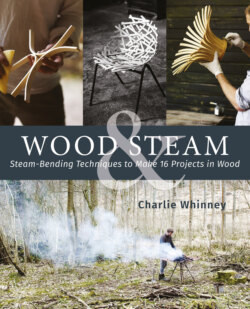Читать книгу Wood & Steam - Charlie Whinney - Страница 9
На сайте Литреса книга снята с продажи.
THE STRUCTURE OF WOOD
ОглавлениеTrees grow outwards, adding a thick veneer of wood over the whole surface of the tree every year. If we zoom in to look at the tiny molecules that make up the cell walls of wood, we see that about 50 percent of wood is cellulose, a very regular polymer chain made of hexagons of carbon linked together with hydrogen and oxygen. Filling the voids between the cellulose molecules is lignin, which makes up about 30 percent of wood. Lignin is a hard-to-pin-down molecule; there will be many types existing together and they share a hydra-like structure, with their limbs wrapped around the adjacent cellulose, binding them together with weak bonds. A popular analogy for wood is to think of it as a composite material like fiberglass. The cellulose chains are like the glass fibers and the lignin like the resin that binds it all together. When we heat wood, electrons speed up, everything is energized, and the bonds between the lignin molecules weaken. When it reaches boiling point, the wood is soft and ready to bend.
If we zoom out now to look at the whole individual cells, the first things you will notice are the shapes. The cells are like long, hollow tubes, all packed together, and they have little holes in the sides that link each cell to the next. Next, you may notice the cells are empty. Living plant cells contain the full complement of organelles for life, but these are long gone here, evacuated only a few weeks after the cell was fully grown, and now even the water and sap that filled the voids prior to heating are mostly gone as the heat has turned it to steam – the heat has actually already partly dried out and seasoned the wood.
If we zoom out again, we will see how the alignment of the cells parallel to the edge of the tree make up the grain of the wood, and that the cells that grow every spring are huge compared to the rest of the year. As we bend the wood, the softened cells start to completely change shape. The cells on the inside of the bend are squashed, the grain zigzags as the wood crumples and compresses. On the outside of the bend, the cells flatten and stretch. When they start to rupture, we learn that we can squash the wood a lot more than we can stretch it. Keep bending and we can see the weak points are the “run-out,” where grain does not run parallel to the surface of the wood and threatens to peel away as we keep bending – better not bend the wood any more in case it breaks! If we had been using a compression strap, we could have kept going, as the steel band on the outside of the bend would have ensured almost all the wood would have been compressed and crinkled. The wood is now cooling. If we release the wood while it is still hot, we will see it unbend until almost straight again, but if we wait for the wood to fully cool, the lignin will have re-set around the cellulose molecules and the “spring back” will be about 25 percent of the bend we have created. The porous plant cells of the wood will still be slightly wet and soft; we need to let dry air circulate around the surface of the wood to allow the cells to set hard. When the wood is dry (less than about 15 percent moisture content) and we release the clamps, the spring back will be only about 5 percent of the bend, and we can call ourselves steam benders!
